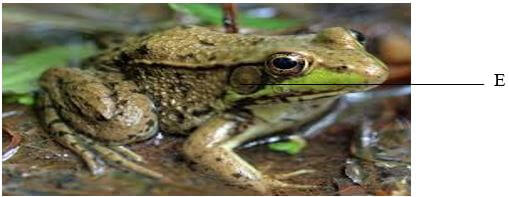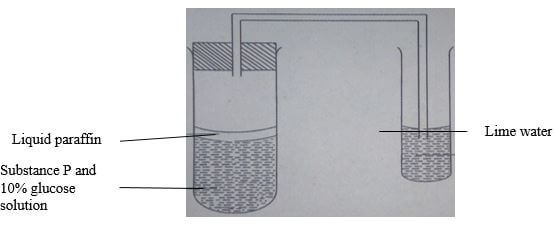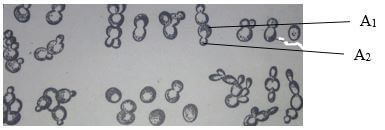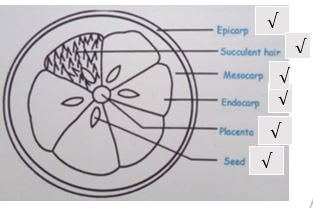INSTRUCTIONS TO CANDIDATES
- Read through the questions and understand them before answering.
- Answer ALL questions in the spaces provided.
- ALL answers must be clear, precise and in correct English
FOR EXAMINER’S USE ONLY
|
QUESTION |
MAXIMUM SCORE |
CANDIDAT’S SCORE |
|
1 |
12 |
|
|
2 |
16 |
|
|
3 |
12 |
|
|
TOTAL |
40 |
|

QUESTIONS
- You are provided with a photograph of a living organism below. Study it carefully and answer the questions that follow.

- Name the class to which the organism belongs. (1mk)
- State two observable features from the photograph for your answer in (a) above. (2mks)
- Name any two organs used for gaseous exchange by the organism in the photograph above. (2mks)
- Give three reasons why the above organism is said to be the most advanced among other organisms in its class. (3mks)
- What is the function of the part labelled E? (1mk)
- State three similarities between organisms of the class identified in (a) above and reptiles. (3mks)
- You are provided with 10% glucose solution, 2 grams of substance P, lime water, a delivery tube connected to a cork, boiling tube, liquid paraffin, hot water bath maintained at 35ºC, measuring cylinder and a means of timing.
Put 20ml of 10% glucose solution into the boiling tube and add substance P. On top of this mixture, add a thin layer of liquid paraffin and set up the apparatus as shown below.
Then place the boiling tube in the hot water bath provided and maintained at 350C. Allow the set-up to stand in the hot water bath for 30 minutes.- Record your observations after 30 minutes in the table below. (4mks)
Observation
Conclusion
- Name the process that took place in the boiling tube. (1mk)
- A drop of the contents in the boiling tube was placed on a microscope glass slide, observations made and recorded as in the photograph below.

Name the parts labelled;
A1.......................................... (1mk)
A2 .......................................... (1mk) - Identify the substance labelled P? (1mk)
- Explain the expected results if the experiment was carried out at different temperatures as follows. Give a reason for each case.
- 5ºC
Expected results (1mk)
Reason (1mk) - 65ºC
Expected result(s) (1mk)
Reason (1mk)
- 5ºC
- Record your observations after 30 minutes in the table below. (4mks)
- You are provided with a specimen labelled S. Use it to answer the questions that follow.
- Using a sharp scalpel provided, make a transverse section of the specimen S. Observe the section and draw a well labelled diagram of the observed features. Show your magnification. (4mks)
- You are provided with a small beaker, test tubes, droppers, test tube holder, white tile and means of heating. You are also provided with iodine solution, Benedict’s solution and DCPIP. Squeeze some juice from the specimen into the beaker. Label it J using a label provided
Using the reagents provided and the juice labelled J, carry out tests to determine type of food present in the specimen. Fill the table below appropriately. (12mks)
Test
Procedure
Observation(s)
Conclusion

MARKING SCHEME
- You are provided with a photograph of a living organism below. Study it carefully and answer the questions that follow.

- Name the class to which the organism belongs. (1mk)
Amphibia; Rej; if begins with small a or wrong spelling or Amphibians
- State two observable features from the photograph for your answer in (a) above. (2mks)
i. Has two eyes with eardrum; (acc: tympanic membrane) behind them
ii. Has (four) well developed limbs for movement - Name any two organs used for gaseous exchange by the organism in the photograph above. (2mks)
i. Lungs
ii. Skin
iii. Lining of mouth/buccal cavity - Give three reasons why the above organism is said to be the most advanced among other organisms in its class. (3mks)
i. Stays more on land than in water
ii. Uses lungs more than the skin for gaseous exchange
iii. Its skin is less moist and can withstand dry conditions - What is the function of the part labelled E? (1mk)
Converts sound waves into mechanical vibrations in order to perceive sound - State three similarities between organisms of the class identified in (a) above and reptiles. (3mks)
Both have double circulatory systems;
Both lay eggs; for reproduction
Both have three chambered hearts (with two atria and one ventricle) apart from crocodiles;
Both are ectothermic;Rej: If the term both is omitted (because it is comparison of two classes)
- Name the class to which the organism belongs. (1mk)
- You are provided with 10% glucose solution, 2 grams of substance P, lime water, a delivery tube connected to a cork, boiling tube, liquid paraffin, hot water bath maintained at 35ºC, measuring cylinder and a means of timing.
Put 20ml of 10% glucose solution into the boiling tube and add substance P. On top of this mixture, add a thin layer of liquid paraffin and set up the apparatus as shown below.
Then place the boiling tube in the hot water bath provided and maintained at 350C. Allow the set-up to stand in the hot water bath for 30 minutes.
Record your observations after 30 minutes in the table below. (4mks)Observation
Conclusion
Bubbles formed/Effervescence takes place
There is production of (Carbon (IV) Oxide) gas
White precipitate/white suspension is formed in limewater
Gas produced is carbon (IV) Oxide which reacts with limewater; to form white precipitate
Acc: calcium carbonate; CaCO3
- Name the process that took place in the boiling tube. (1mk)
Anaerobic respiration/Alcoholic fermentation; Rej: Respiration alone - A drop of the contents in the boiling tube was placed on a microscope glass slide, observations made and recorded as in the photograph below.

Name the parts labelled;
A1 Parent cell (1mk)
A2 Bud (1mk)
- Identify the substance labelled P? (1mk)
Enzyme/ Yeast - Explain the expected results if the experiment was carried out at different temperatures as follows. Give a reason for each case.
- 5ºC
Expected results (1mk)
Low rate of reaction/ less carbon (IV) oxide produced
Reason (1mk)
Enzyme/Yeast deactivated by very low temperature. (Rej; if the word very is omitted) - 65ºC
Expected result(s) (1mk)
Reaction stopped/ No carbon (IV) oxide produced/ No effervescence/bubbling (OWTTE) Rej: Low rate of reaction/ Less carbon (IV) produced; No observable change
Reason (1mk)
Enzyme/Yeast destroyed/denatured by very high temperature.
- 5ºC
- You are provided with a specimen labelled S. Use it to answer the questions that follow.
- Using a sharp scalpel provided, make a transverse section of the specimen S. Observe the section and draw a well labelled diagram of the observed features. Show your magnification. (4mks)

E.g. Magnification = X ½ or any other relevant figure. (Not part of marking in this paper but important to always indicate)
NB: The diagram mark scores only when;
• It has two continuous outer lines and outline for all other structures is continuous.
• Label lines are continuous, touching the intended structure, not crossing one another and not arrows
• It has no shading.
Please note that unless it is a wrong diagram, a student may miss a the diagram mark but score on labels. Wrong diagram constitutes;
• Diagram of other parts of plant or animals other than fruit or a longitudinal section of the fruit. - You are provided with a small beaker, test tubes, droppers, test tube holder, white tile and means of heating. You are also provided with iodine solution, Benedict’s solution and DCPIP. Squeeze some juice from the specimen into the beaker. Label it J using a label provided
Using the reagents provided and the juice labelled J, carry out tests to determine type of food present in the specimen. Fill the table below appropriately. (12mks)
Test
Procedure
Observation(s)
Conclusion
Iodine/Starch test
Put some juice J in a clean test tube. Add iodine solution to the juice J.
Rej; Wrong procedure (for all procedures) and don’t continue marking other columns
Color of Iodine retained/persists
Starch absent
Rej; Absence of starch
DCPIP/Ascorbic acid/Vitamin C test
Put some DCPIP in a clean test tube. Add the juice J dropwise while shaking and observe.
DCPIP is decolorized/turn from blue color to colorless
Ascorbic acid/Vitamin C present.
Rej; Presence of……….
Benedict’s/Reducing sugars test
Rej; if started with a small b
Put some juice J in a clean test tube. Add equal amount of Benedict’s solution. Heat the mixture to boil/boiling.
Rej; if equal is omitted
Color changes to orange/red/brown.
NB: If a students commits to write all the colors, the sequence MUST be correct….color changes to green, yellow and orangered/brown.
Reducing sugars present.
Rej; Presence of……….
- Using a sharp scalpel provided, make a transverse section of the specimen S. Observe the section and draw a well labelled diagram of the observed features. Show your magnification. (4mks)
Download Biology Paper 3 Questions and Answers - Mathioya Mock 2021 Exams.
Tap Here to Download for 50/-
Get on WhatsApp for 50/-
Why download?
- ✔ To read offline at any time.
- ✔ To Print at your convenience
- ✔ Share Easily with Friends / Students

